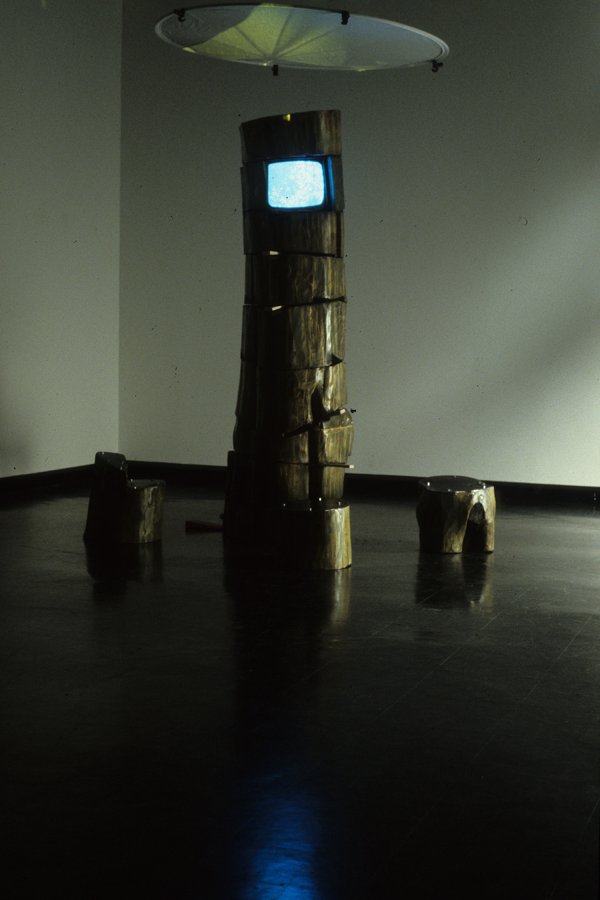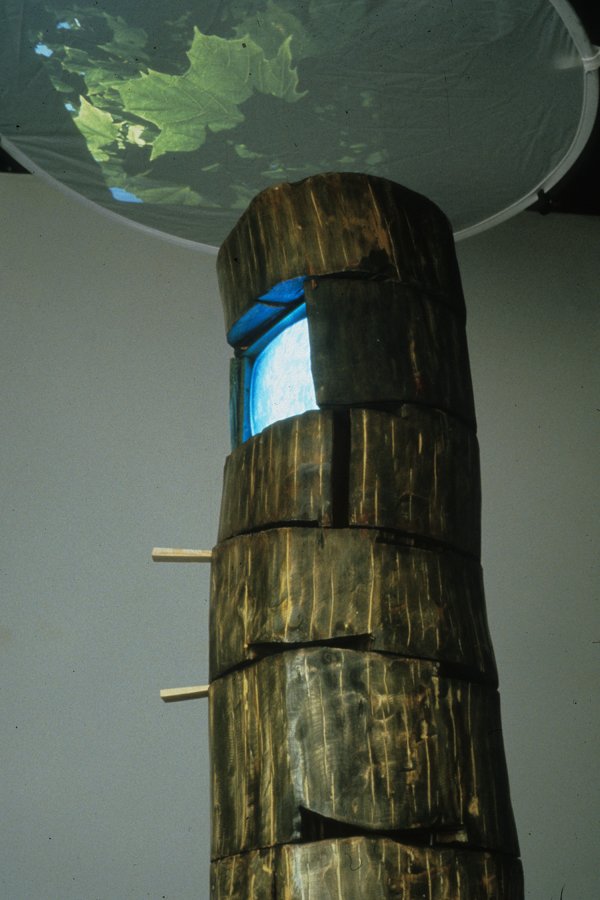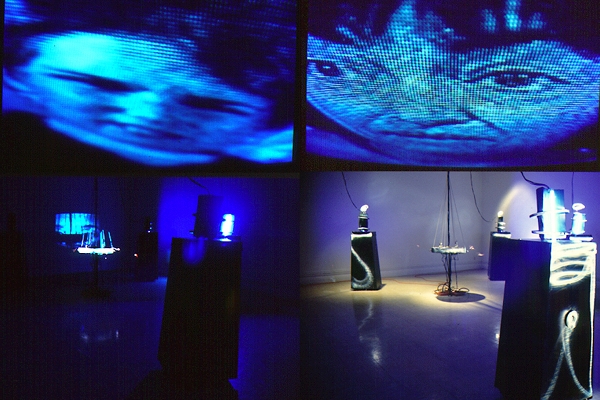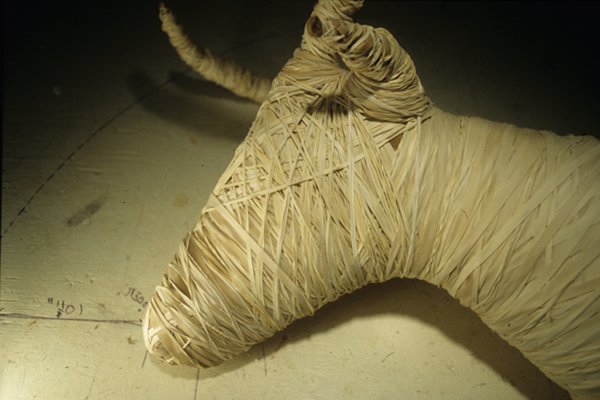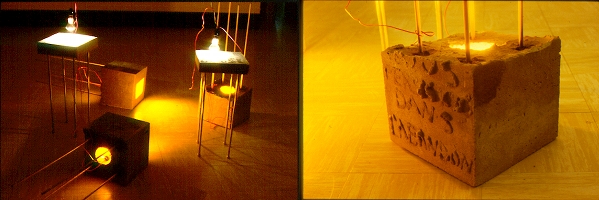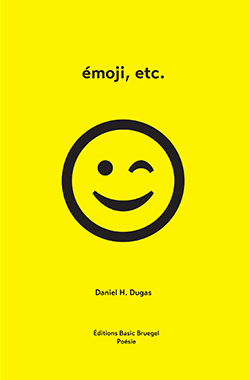Acadia Woods (1994)
Statement
In 1844 when Samuel Morse sent the first telegram in the United States, he breathed life into communication technology. That first message between Washington and Baltimore read, “What hath God wrought.”
A few years later, Henry David Thoreau wrote in Walden: …We are in great haste to construct a magnetic telegraph from Main to Texas; but Main and Texas it may be, have nothing important to communicate. …
In the sound track of Acadia Woods, we have extracted portions of actual telephone conversations between family and friends. Through these everyday conversation, distances become lessened; the separations created through time and space shrink. Under these circumstances, the mundane crosses over into the profound.
The re-creation of telephone lines with tin cans (the sound track plays inside headphones installed in the cans) is an attempt to relocate the technology in its context of a tool, second in nature to communication.
Valerie LeBlanc and Daniel Dugas
Calgary, AB
Excerpt form Broad Casting for reels (1996)
The tape Acadia Woods 1995 was also designed as an audio work complete in itself. It is a patchwork of stories and sounds with the Acadian anthem ‘Ave Marie Stella’ running throughout. Portions of long distance telephone conversations between family and friends change speed with the different energy levels of the people talking and according to their concerns. Seasons and the passage of time are indicated in the conversations and sound effects. Everyday philosophies take on added significance through the link of the telephone, which is sometimes the only way to really feel out what is happening at a distance.
This audio portion of the project was realized at the Banff Centre through a grant from Chameleon Arts Society, Calgary, AB (Spring 1994)
Two versions of the project were realized:
Acadia Woods (east), CMARTS – exposition – retrospective, August 12 – August 21, 1994 (using the telephone pole installation format)
Acadia Wood (west), Muttart Public Art Gallery, during the exhibition ‘Impact of Technology’, January 2 – February 4, 1995 (using a shuffleboard-style high end table)
The project was also broadcast, presented at the following venues:
1994 Acadia Wood, CKUA – Radio Network, Edmonton, AB
1996 Broad Casting for reels 007, CKDU FM, Centre for Art Tapes Halifax, NS
1998 AUDIO / VIDEO, GAUM, Moncton, NB
Wood, tin cans, sound track48 in. h. X 20 in. w. X 96 in. d.
Transitory (1993)
• The School of the Art Institute of Chicago, MFA Show, Chicago, IL, 1993
Outils sociaux (1993)
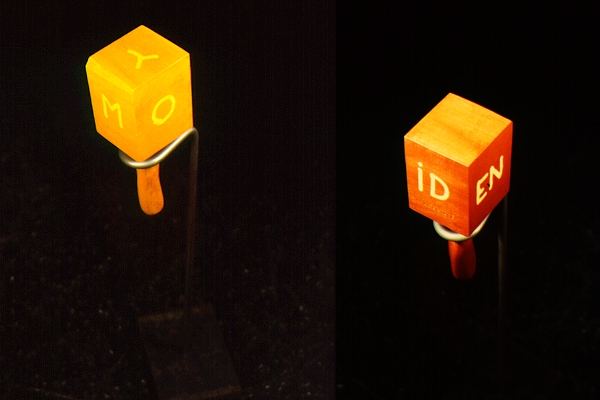
• Auction at Sculpture Space, Utica, NY 1993
L’installation comprends 11 maillets en bois teinté rouge ou jaune. Sur chaque maillet est gravé un mot idée: Temps, Space, Money, Loi, Duty, Riot, Assez, Rêve et Identité. Exploration de l’ambivalence et du contraste qui existe entre le concept de l’outil et le concept de l’arme, de la construction et la destruction.
Chaque maillet: 12 in h. X 5 in. w. X 5 in. d. tuge métallique: 30 in. h.
La boîte de Pandore (1991)
• Galerie d’art Louise et Reuben-Cohen de l’Université de Moncton, NB, 9 juillet – 31 août 2008
• A.K.A. Saskatoon, SK, June 7 – June 29 1991
• Galerie Sans Nom, Moncton, NB April 2 – April 23 1991
Created in January and February 1991 during a residency at Sculpture Space,Utica, NY, an internationally reknowned artist-in-residence program for sculptors.
The New Pandora’s box – an installation-projection about television.
I left Canada for England with a grant from the Canada Council – August 1, 1990 on the first leg of a world research trip. The idea was to revisit the myth of Pandora’s Box and to capture ‘evils of the world’ through video and sound recordings. The invasion of Kuwait by Iraq on August 2 forced me to change my itinerary and to reconsider the parameters of my research. During the 40 days of my travel, I saw a world glued to television sets, waiting for something to happen. Television as medium evolved to be both topic and base for my project.
The Installation was made of 5 elements, four buoys: rocking structures made of wood and the control cabinet: the disc. Each buoy was fitted with a slide projector and a cassette deck connected to the disc. Visitors could activate projections and soundtracks by opening the drawers of the cabinet.
The slides and the soundtracks were constructed with material garnered from television itself, photo stills and sound bites taken from talk shows and daytime TV.
The construction of The New Pandora’s Box took place at Sculpture Space from December 2, 1990 to January 30, 1991. Operation Desert Storm began with an aerial bombardment on 17 January.
Dimensions
4 pieces: 75 in h. X 24 in w. X 20 in d.
1 piece: 24 in dia. X 5 in h.
Soundtracks duration: 45 minutes
240 slides
Le poids de la beauté / The Weight of the Beauty (1990)
Work for 3 dead minks, one deer leg and 5 capitals
February 27 – March 1, 1990
Glyde Hall, The Banff Centre for the ArtsBanff, Alberta
Sur la route qui me ramène de Calgary
Au son de l’harmonica de Dylan
sur “What was it that you wanted”
Je croise un chien mort, so,
Je réalise que dans les Foothills,
on meurt aussi dans la Beauté
Cowboy Caruso (1990)
Saint Mary’s Unniversity Art Gallery Halifax, NS February 8 – March 11 1990
Cowboy-Caruso est une figure mythique qui veut le meilleur des deux mondes; la liberté et les grands espaces du cowboy et le raffinement du monde de l¹opéra. Basé sur l’histoire vraie de Ted Wilson ancien cowboy au Texas, travailleur dans les champs pétrolifères du Nord puis chanteur d¹opéra dans les rues de Calgary.
Deux structures reliées électriquement, l’une COWBOY, l’autre CARUSO engage via le spectateur un dialogue chaotique. Quatre tiroirs en forme de quart de lune peuvent être tirés hors de Cowboy. Chaque tiroir a une fonction spécifique: 1. déclenche le système sonore; le haut-parleur droit est installé dans Cowboy et le haut-parleur de gauche dans Caruso. 2. déclenche un baril tournant installé à l¹intérieur de Caruso. 3. déclenche un projecteur diapositives installé dans Cowboy. 4. déclenche un trophée tournant sur Cowboy. La structure Caruso est déposée sur une table de métal. Quatre chaises sont installées face à quatre ouvertures. Lorsque concordent les ouvertures dans le baril tournant avec les ouvertures sur la structure elle-même une scène mélancolique, éclairée avec des black light apparaît puis disparaît lentement. Il s¹agit d¹une forêt miniature faite de bois de chevreuils où pendent des médaillons photographiques. Sous la table sont éclairés avec des black light cinq fers à cheval fluorescents. La projection de diapositives vertes est constituée de gros plans de dessins de travaux quotidiens du cowboy. La bande sonore comprends des airs de l’ouest chantés par Ted Wilson. Le tout fut manipulé en studio.
Installation
2 pièces: 48 in. dia. X 12 in. h.
base de Cowboy: 48 in dia. X 48 in. h.
base de Caruso: 48 in. h. X 24 in. w. X 24 in. d.
La boîte rouge (1989)

• Saint Mary’s Unniversity Art Gallery, Halifax, NS 8 février – 11 mars 1990
• Galerie Sans Nom, septembre 1990
La boîte rouge
La boîte rouge montée sur un support d’acier et la chaise fluorescente éclairée par des black lights sont reliés électriquement. Des commandes électriques installées sur la chaise activent un système sonore ainsi que deux projecteurs diapositives. La projection est fragmentée par des miroirs fixés sur la boîte. D’autres commandes, installées sous la boîte activent des composantes lumineuses installées dans un périscope qui peut être tiré hors de la boîte. La projection de diapositives ambrées est composée de close-ups d◊images recueillies dans les journaux. La bande sonore consiste en un collage de percussions et de 30 différents proverbes français
“There is the same difference between a pain that someone tells me about and a pain that I feel as there is between the red that I see and the being red of this red leather box. Being red is for it what hurting is for me. Just as there is an I-John Doe, there is also an I-red, an I-water, and an I-star. Everything, from a point of view within itself, is an I.”
José Ortega Y Gasset
Daniel H. Dugas
Archives
Blogroll
- A.I.R. Vallauris
- ACAD
- Adobe additional services
- Adobe Creative Cloud
- AIRIE
- Amaas
- Amazon Author Central
- ARTothèque
- Australian Poetry
- Basic Bruegel
- Bitly
- CCCA
- CDBaby
- Cycling 74
- Dissolution
- Éditions Prise de parole
- Emmedia
- eyelevelgallery
- FAVA
- Festival acadien de poésie
- Festival FRYE Festival
- FILE – Electronic Language International Festival
- Freeware list
- Fringe Online
- Galerie Sans Nom
- Gotta Minute Film Festival
- Instants Vidéo
- JUiCYHEADS
- Kindle Direct Publishing
- Klondike Institute of Art and Culture
- La Maison de la poésie de Montréal
- La Maison de la Poésie et de la Langue française Wallonie-Bruxelles
- Laboratorio Arte-Alameda
- Le Centre Jacques Cartier
- Liberated Words
- Maison Internationale de la Poésie – Arthur Haulot
- MediaPackBoard
- Miami Book Fair International
- Monoskop
- Mot Dit
- NSCAD University
- Paved Arts
- PoetryFilm
- Portail des auteurs du Nouveau-Brunswick
- RECF
- Revue Ancrages
- Salon du Livre du Grand Sudbury
- Sculpture Space
- Subtropics.org
- Sydney college for the arts
- The Centre for Contemporary Canadian Art
- The New Gallery
- Trevigliopoesia
- tumbler-documents
- V Tape
- Valerie LeBlanc
- VideoBardo
- Void Network-Κενο Δίκτυο
Categories
- #covidpoèmes
- Advertisement
- AIRIE
- Ancrages
- anthology
- Anthropocene
- Architecture
- Around Osprey
- art
- Article de presse
- arts visuels
- audio
- Australian Poetry
- Basic Bruegel Editions
- Book
- book fair
- Cafe Poet Program
- Ce qu'on emporte avec nous
- Citations gratuites
- Collaboration
- commentaire
- commentary
- Compte rendu
- conférence
- Conservation Foundation of the Gulf Coast
- COVID-19
- Critique littéraire
- culture
- Daniel Dugas
- Design
- Édition Michel-Henri
- Éditions Perce-Neige
- Éloizes
- Emmedia
- emoji etc | émoji etc
- Environnement
- essai
- essay
- Everglades
- Exhibition
- festival
- Festival acadien de poésie
- Festival Frye Festival
- FIPTR
- Flow: Big Waters
- Fundy
- Habitat
- installation
- Instants Vidéo
- interactivity
- journal
- JUiCYHEADS
- Kisii
- L'Esprit du temps
- laptop
- Leaving São Paulo
- lecture
- Livre
- logos
- Magazine
- Miami Book Fair
- Moncton 24
- novel
- OASIS
- oil spill
- perception
- performance
- Photo
- poésie
- Poetic Licence Week
- Poetry
- politics
- politique
- press
- Prise de parole
- Revue Ancrages
- salon du livre
- sculpture
- Sculpture Space
- sound
- Souvenirs
- Spirit of the Time
- Style & Artifacts
- Symposium d'art/nature
- talk
- television
- The New Gallery
- Uncategorized
- Valerie LeBlanc
- vidéo
- vidéopoésie
- Videopoetr/Vidéopoésie
- videopoetry
- visual arts
- What We Take With Us
- youth literature








